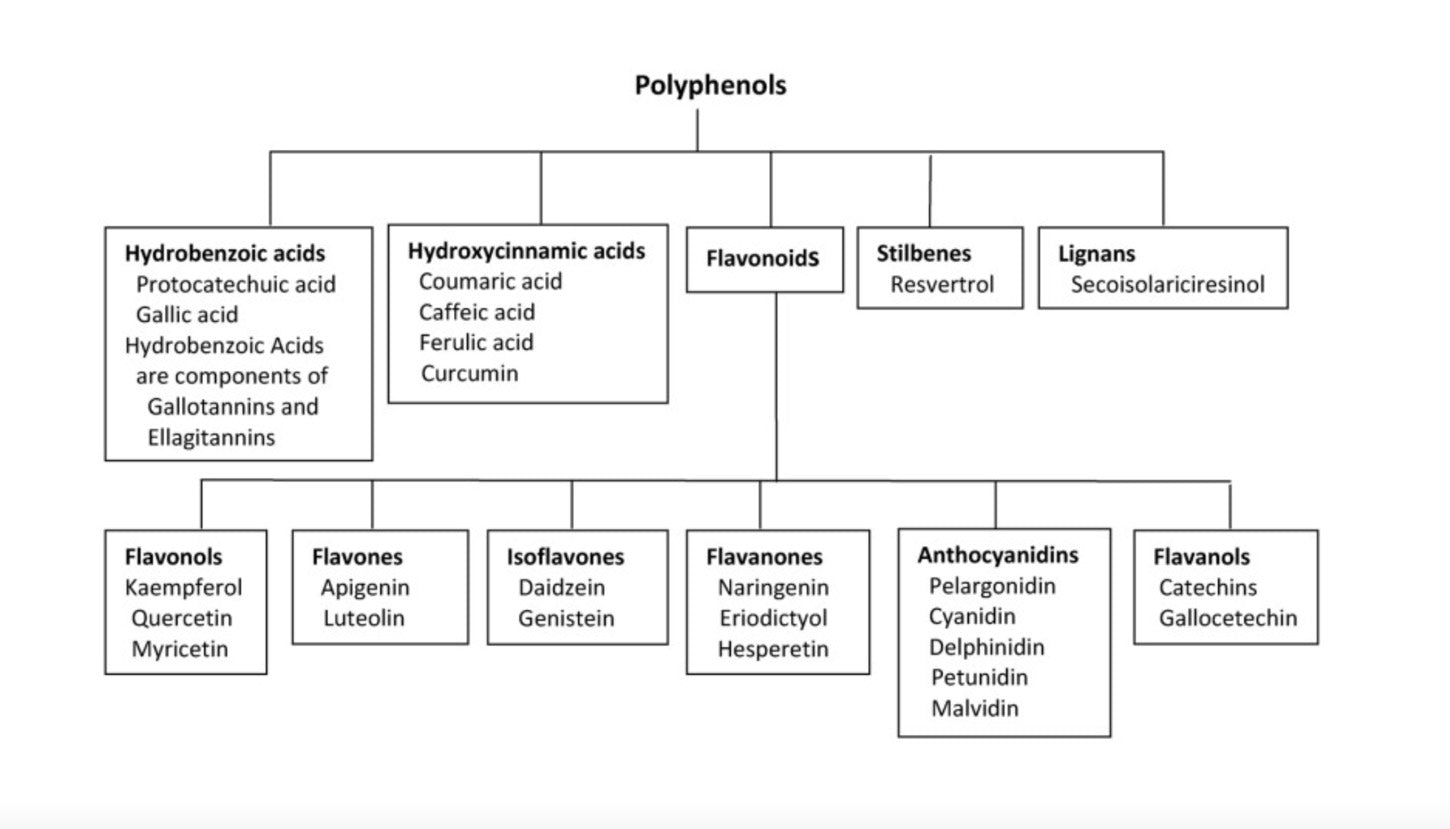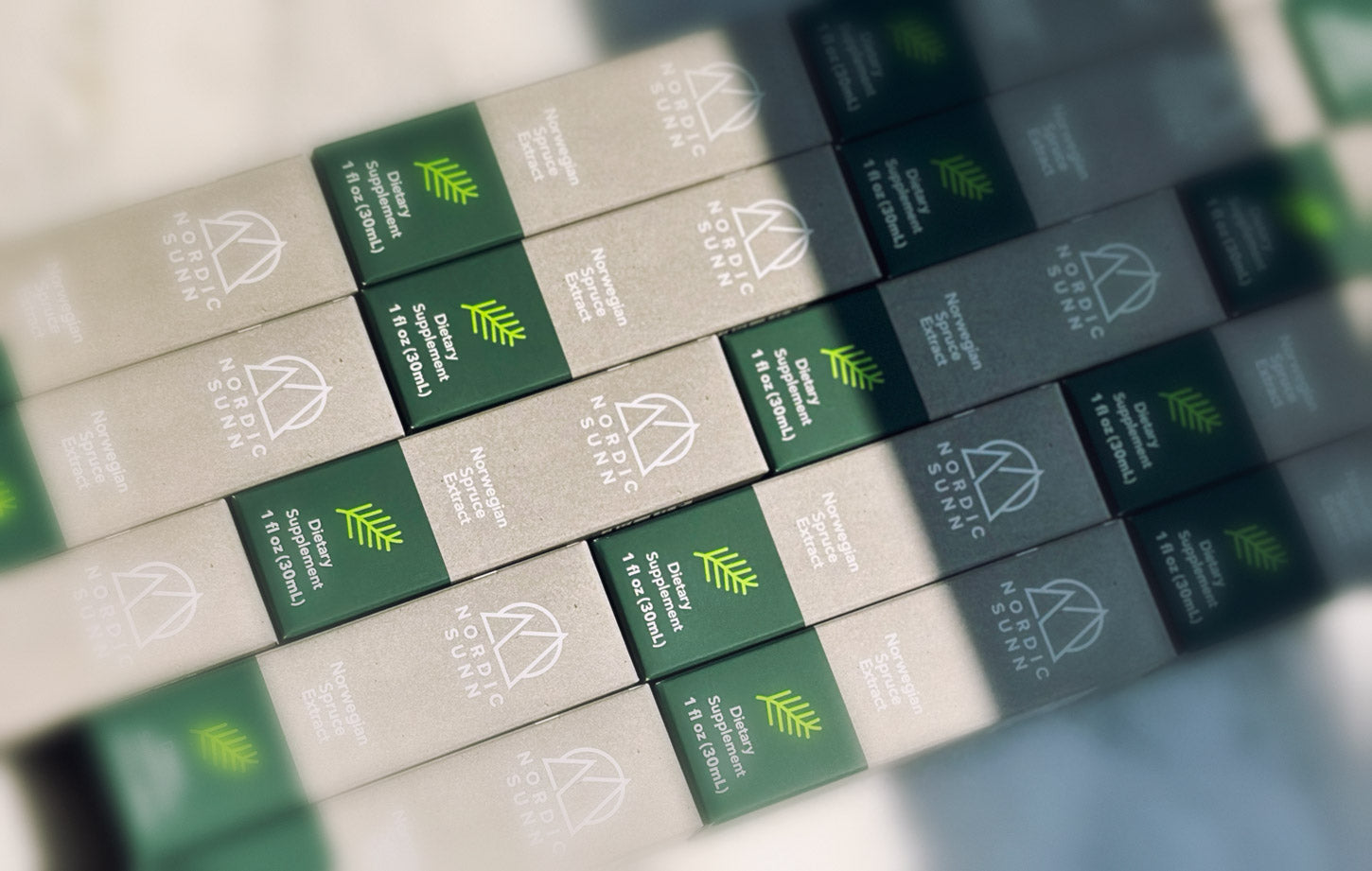The Science
To understand the benefits of Nordic Sunn Norwegian Spruce Extract, we need to understand the science behind this magical health supplement. We start the discussion with Polyphenols.
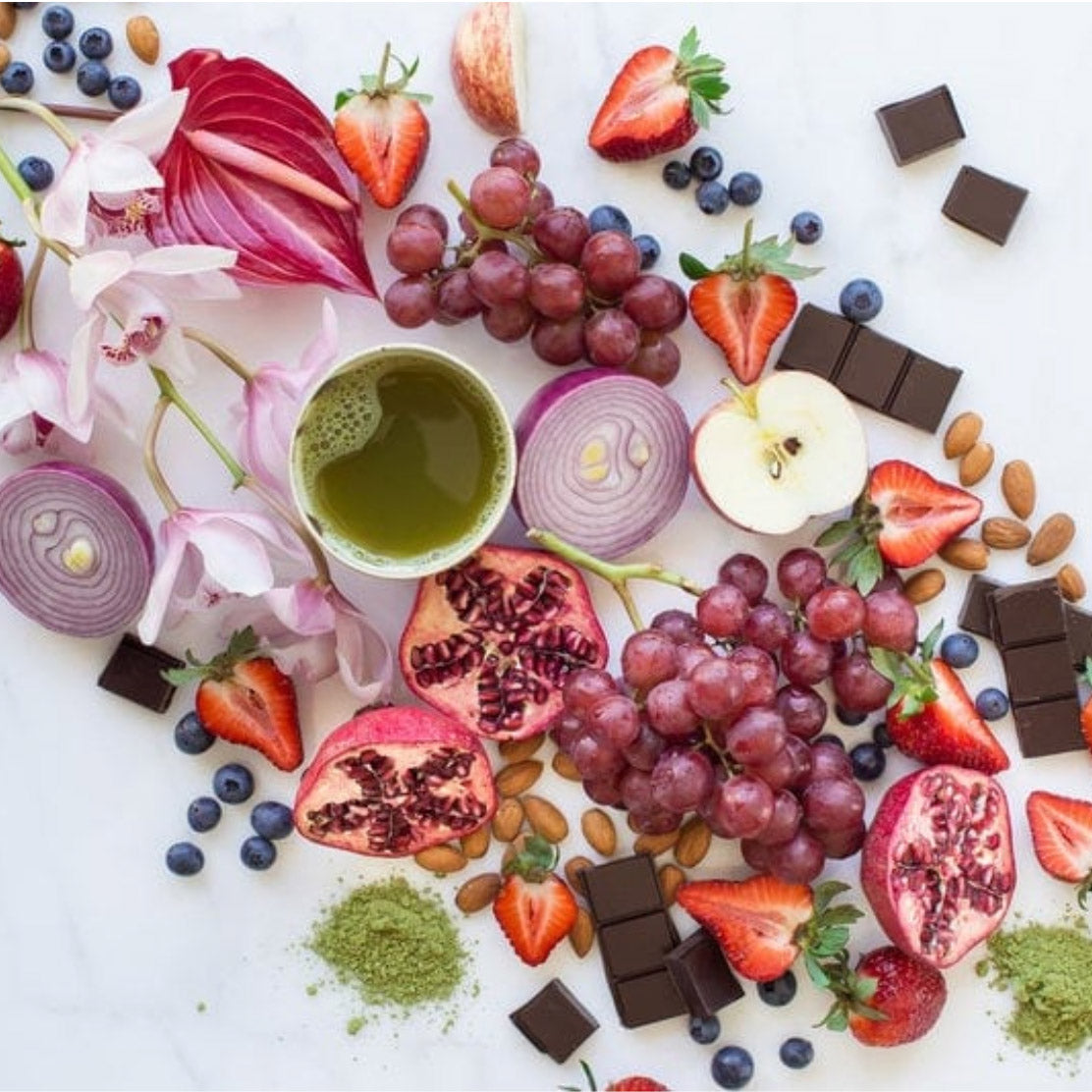
POLYPHENOLS
There are over 8,000 polyphenolic compounds in the plant world (62). Berries, green tea, coffee, cocoa, some spices and even red wine all contain polyphenols and have strong antioxidant properties.
Polyphenols in plants protect them from harmful UV radiation as well as attacks from harmful pathogens.
Polyphenols are also powerful micronutrients that our bodies use to stay healthy . They have numerous health benefits that may offer protection from the development of cancers, cardiovascular disease, osteoporosis, and diabetes. (62) All polyphenols have various bioavailability which will depend on the type of polyphenol as well as the colon microflora.
While it’s ideally best to get these nutrients through our diet, sometimes an unbalanced diet prevents us from getting as much as we need.
Polyphenols are grouped in 4 major classes: phenolic acids, flavanoids, stilbenes and lignans.
Nordic Sunn’s Norwegian Spruce Extract contains several lignans sourced from spruce trees in Scandinavia.
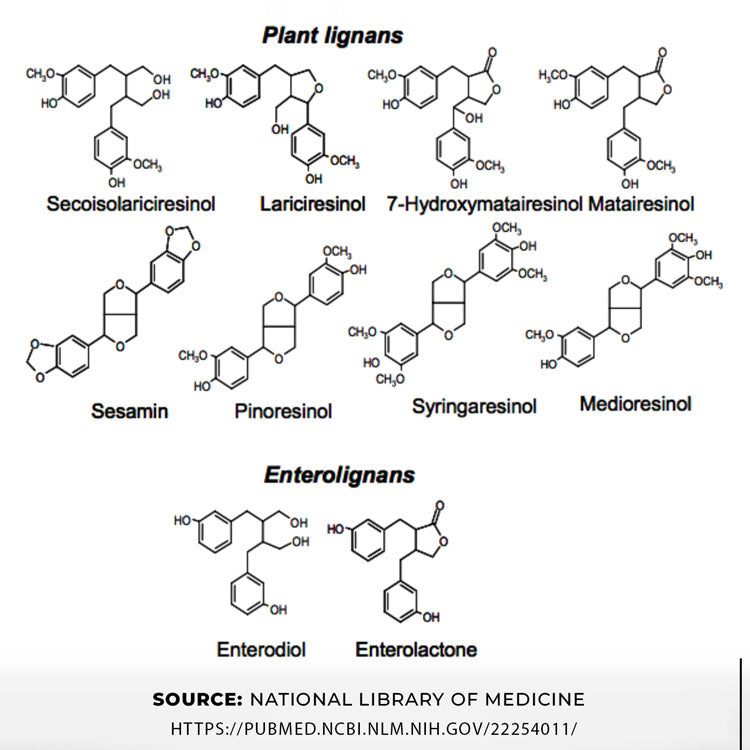
LIGNANS
A lignan is a polyphenolic compound that occurs naturally in some plants, rye, barley, seeds, fresh fruits, broccoli, and some berries. In recent years research has shown that a significant amount of lignans are also present in trees, especially the knots of the wood. (87)(38)
It is known that the accumulation of lignans in the core of trees is important for the durability and longevity of the species. (61) Lignans’ roles in the longevity of trees may be the key to their nutritional benefits.
Major plant lignans known are secoisolariciresinol, matairesinol, pinoresinol, sesamin and hydroxymatairesinol. Similar to isoflavonoids (most commonly soybeans) lignans are phytoestrogens.
Isoflavonoids and lignans in various foods can be measured via gas chromatography (63), with soybeans and flaxseed having the highest lignan contents of plants studied.
Many diseases, in particular hormonal related cancers such as breast cancer, have been observed to be much more prevalent in the West than Asia. There is some evidence that diet plays a role. Populations consuming more phytoestrogens have been found to have a reduced risk of breast, colorectal and prostate cancer. In Asia consumption of soybeans (an isoflavone) represents the largest intake of phytoestrogens, while in the Western diet they come in smaller quantities from lignans in whole grains, seeds and vegetables. (63)
Through the action of bacteria in the digestive system, plant lignans are the precursor to the major mammalian lignans Enterodial (ED) and Enterolactone (ENL). These mammalian lignans were first discovered in the late 1970s and are thought to be responsible for some of the health benefits of lignans. These mammalian lignans are thought to act as anti-oestrogens when oestrogen levels are too high, and the other way around when they are too low.(61)
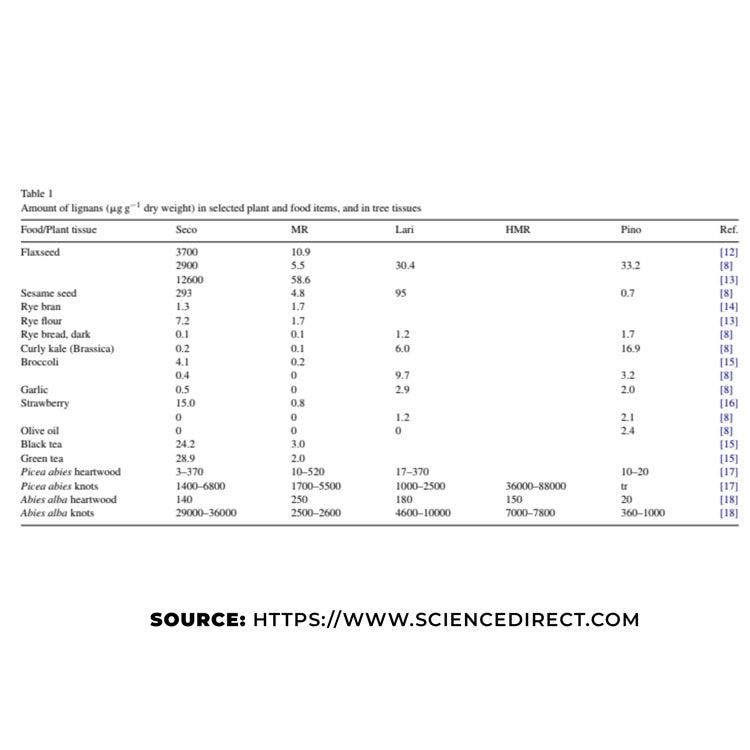
NORWEGIAN SPRUCE EXTRACT
Lignans were first discovered in trees over 100 years ago. The norwegian spruce extract, collected from the knotwood of the tree (Picea Abies) is thought to be one of nature's highest concentration of lignans available (50) (38)
Knots in trees have been shown to have 5-10% dry weight of lignans, much higher than ordinary stemwood, with the Norwegian Spruce containing 6-24% of lignans, this being 50 to 100 times higher than in normal wood (54)
Flaxseed is also known to have the highest concentration of lignans in the plant world, however Chromatographic analysis of lignans shows that Norwegian Spruce knotwood extract has between 10 and 20 times more lignans than flaxseed (50)(61).
Norwegian Spruce knotwood lignans are primarily composed of 7-hydroxymatairesinol (HMR). But is also possesses a large amount of other lignans as well
Using more recent measurements techniques, it was found that HMR is also the major lignan source in wheat, oat, barley and bran, but still in much smaller amounts than those found in Norwegian Spruce. (53)
LIGNANS AND METABOLISM
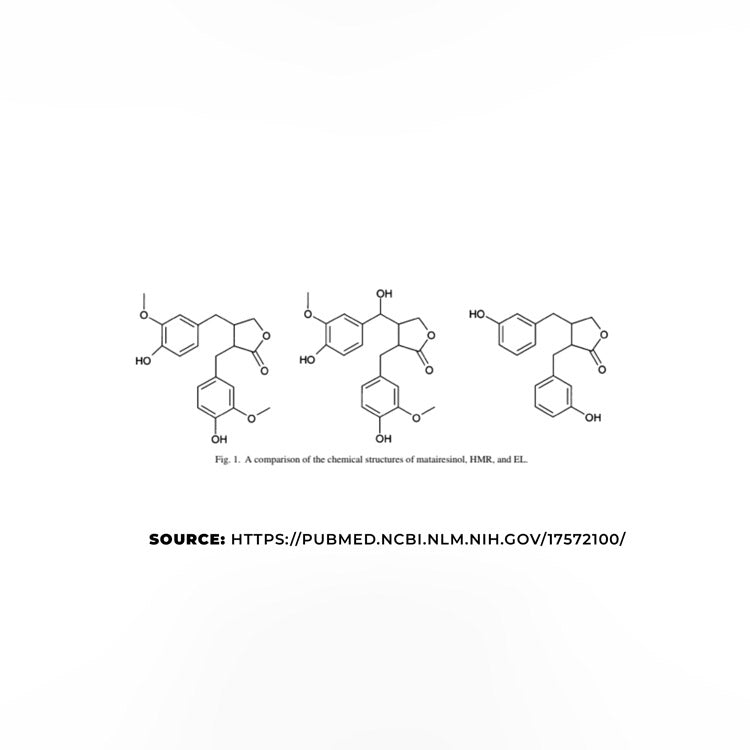
As seen previously, norwegian spruce knotwood and flaxseed are both major sources of lignans in nature.
Norwegian Spruce knotwood contains mostly the lignan hydroxymatairesinol (HMR). Hydroxymatairesinol then gets converted to matairesinol (MAT) through hydrogenolysis and then mostly into enterolactone (ENL) and some enterodiol (ED) through bacteria in the gut. (56) Norwegian Spruce knotwood also contains secoisolariciresinol (SECO), matairesinol (MAT) and lariciresinol (LARI). (50) The chemical structure of HMR is closely related to MAT, and, therefore provides an efficient precursor of ENL. (13)
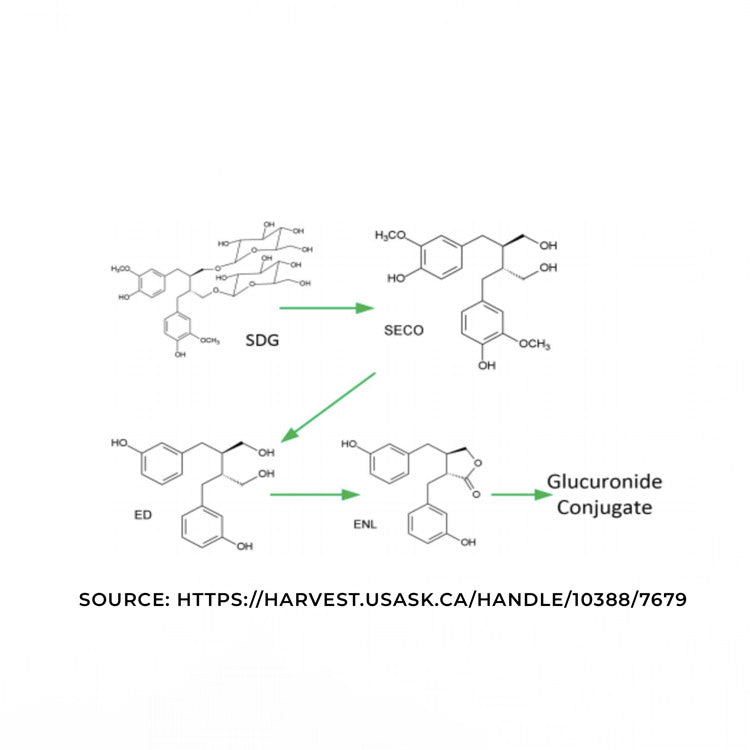
One of the advantages of HMR in Nordic Sunn is that it occurs in its aglycone form (without a sugar) which some research on other polyphenols and phytoestrogens suggests may increase its bioavailability. (99) (86)(133)
Flaxseed lignans on the other hand need to go through a multiple step process. Flaxseed contains a large amount of the lignan precursor secoisolariciresinol diglucoside (SDG). SDG then gets metabolized in the gut to the lignan secoisolariciresinol (SECO). SECO then gets broken down by the microflora into mostly ED . ED is then partially converted into ENL in the colon. (52)(51)
A similar process happens with sesame seeds, also high in lignans. Sesaminol triglucoside (STG) is the most abundant lignan in sesame seeds and first needs to be metabolized to an aglycone (lignan without sugar) (14) (64)
The lignans are thought to only be effective if they are metabolized, absorbed and reach the tissues, where they can potentially exert an effect. Some of the health benefits studied seem to accrue from an increased level of ENL, which HMR converts into directly. (21) Research shows that HMR is quickly absorbed by the body into blood plasma (9).
Because lignans need to be metabolized in the gut, a healthy gut flora and a high bioavailability of the lignans are suspected to be both important to achieve the maximum health benefits. Patients who are taking antibiotics, for example, can have reduced gut flora, leading to reduced absorption of lignans. Other factors such as sex, BMI and smoking has also been shown to have an impact on overall ENL levels. (51) (88)
One of the big advantages of Nordic Sunn’s Norwegian Spruce extract is its lignans are in aglycone form. Some research shows that lignans in their aglycone form can be absorbed more easily and earlier than their glycosated lignan equivalents. (86)
LIGNANS AND HEALTH
Epidemiological studies have proved that lignan-rich diets help reduce risk of various
hormone-dependent cancers, heart disease and osteroporosis. (61) While Asian populations get most of the phytoestrogens in their diet from isoflavones present in soybeans, Western populations get most of their phytoestrogens from lignans.
Lignans are ubiquitous in the plant kingdom, albeit in small quantities. Most people consume some lignans as part of their diet, with vegetarians usually consuming more. The ongoing EPIC cohort study, following 477,312 men and women in 10 European countries, confirm that daily lignan intake is 1.5 mg/day on average with a standard deviation of 0.8 mg/day. (34) Over 40% of lignan intake came from fruits and vegetables. This is consistent with another cohort study of 637 Dutch men and women where the average intake of lignans was about 1 mg/day. (83)
The typical Western-type diet which has high fat levels can result in altered hormonal levels, including elevated androgen levels. This diet elevates plasma levels of sex hormones and decreases the sex hormone binding globulin (SHBG) concentration, increasing the bioavailability of these steroids. This also results in low levels enterolignans (ENL,ED) and phytoestrogens. (70) Lignans could serve to counteract some of the effects of hormonal imbalance due to high dietary fat intake. (25)
Due to the similarity of the chemical structure of the enterolignans with estradiol, there has long been the suggestion that these lignans have weak estrogenic/antiestrogenic properties. The chemical structure of lignans also makes them promising anti-oxidants.
Epidemiological studies point to the benefits of lignans in the diet:
According to the Zutphen cohort study that followed 570 Dutch men between 64 and 84 for 15 years, intake of enterolignans, particularly matairesinol (MAT) was inversely associated with death due to coronary heart disease, cardiovascular disease, cancer and all cause mortality. (69) The fact that MAT stood out as most beneficial is of interest as 7-hydroxymatairesinol (HMR) is a direct precursor to MAT and both primarily get metabolized to the mammalian lignan enteralactone. (69)(83)
The possibility of polyphenols affecting the gut microbiota and, as such, acting as probiotics has also been explored. (110)
The lignans appear unique among the phytoestrogens in their ability to modulate
steroid activity via the aromatase enzymes.Lignans inhibit the activity of human aromatase, 17β-hydroxysteroid dehydrogenase, and 5α-reductase (25)
In summary, lignans have shown a strong potential to help balance hormones, and act as powerful anti-oxidant on the body with a variety of benefits.
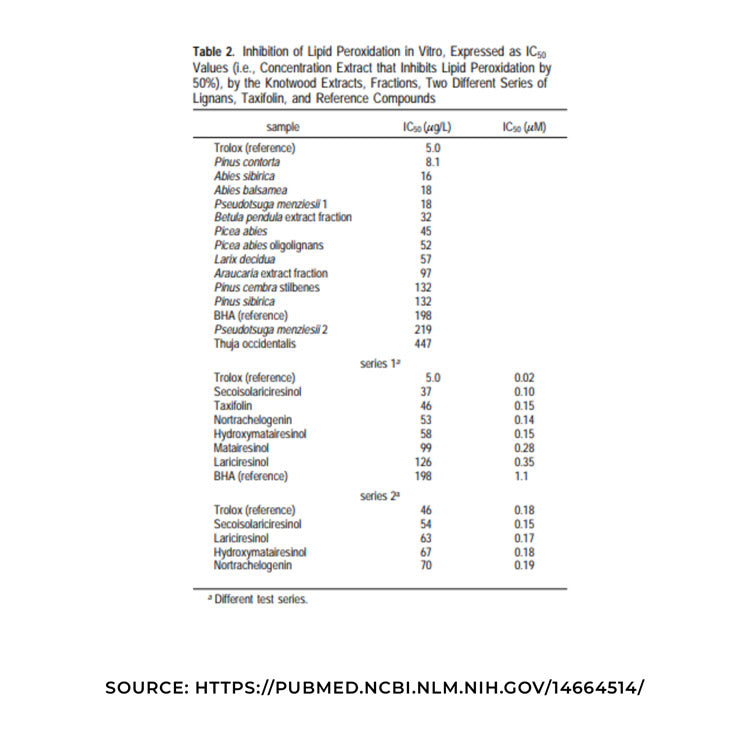
POWERFUL ANTIOXIDANT
We live in a world where free radicals can come from many sources and contribute to the deterioration of health. Sources of free radicals include pollutants, drugs, metal ions, radiation, and high intakes of polyunsaturated fatty acids, and also strenuous exercise, mitochondrial dysfunction, and smoking. (87)
One of the benefits of lignans is thought to be due to antioxidant activity, primarily as an efficient hydroxyl radical scavengers. (96) Research done on various wood species, and especially knotwood and bark showed its strong anti-oxidant potential. (37)
Some research shows the mammalian lignan metabolites (enterodiol and enterolactone) may actually have greater or different activity than the parent lignan. (103)
SECO, ED and ENL were all found to be 4.5 to 5 times more powerful than Vitamin E as a direct antioxidant. (87)
HMR, the lignan found in the Norwegian Spruce knotwood, is also known to be a powerful antioxidant. When comparing to Trolox (the reference for anti-oxidation) HMR ranked higher than SECO, the major lignan in flaxseed, as an anti-oxidant. (106)
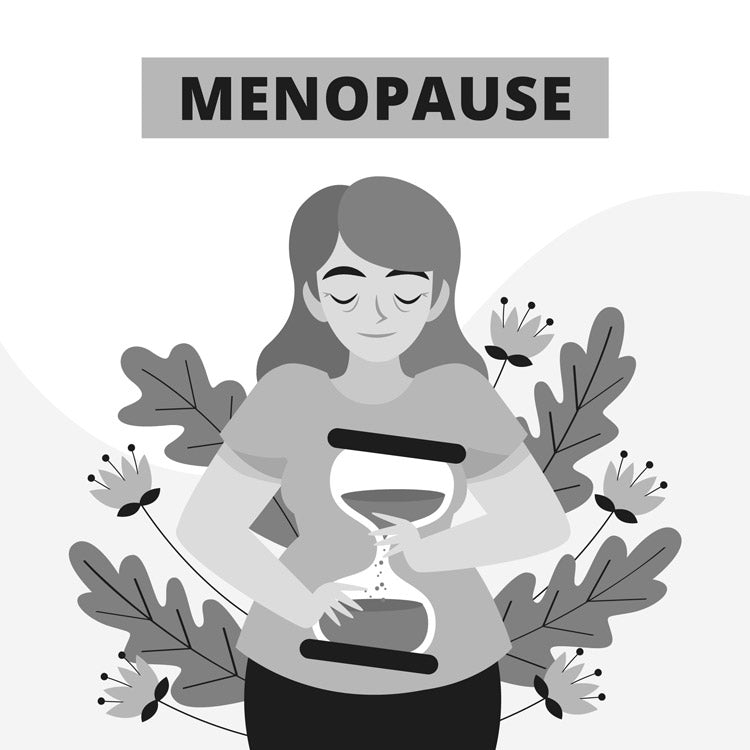
MENOPAUSAL SYMPTOMS
The behavior of the phytoestrogen lignans depends on the biological levels of estradiol . It is thought that at normal estradiol levels, the lignans act as estrogen antagonists, but in postmenopausal women (and thus low estradiol levels) they can act as weak
estrogens. (61) (87) This could lead lignans to have both estrogenic and anti-estrogenic effects and benefits..
In women going through menopause, the hormonal balancing impact of phytoestrogens have been shown in various studies to help with menopause symptoms such as hot flashes. (101) (102)
In one study, Japanese women have historically shown low incidence of menopause symptoms compared to Canadian women. (67) This is presumed to be due to the Japanese diet being high in phytoestrogens through soybean consumption. In a collaborative studies phytoestrogens soy and flaxseed both had strong positive effects on hot flashes and vaginal dryness. (68)
In a study specifically done using a norwegian spruce extract , researchers found that supplementation led to a 50% decrease in hot flashes (9), while another study showed the hormonal balancing effects of HMR supplementation. (40)

STRESS
There is evidence that steroid production by human fetal adrenal cortical cells is modulated by estrogen, and thus phytoestrogens could play a hormonal balancing role. Phytoestrogens have also been studied to their impact on sleep and stress, with possible beneficial impact on both.
In one study, looking at ENL levels showed an inverse relationship with short sleep and probability of sleep disorders. This was not the case for END which showed a negative relationship. (93) It is thought that phytoestrogens may increase DHEA synthesis and decrease cortisol synthesis by suppressing the activity of the enzyme 21-hydroxylase.(129)

BREAST HEALTH
Epidemiological studies have shown that Asian populations with a higher intake of phytoetrogens had a lower incidence of various hormonal related cancers than Western populations. (63) This had led to much research on the benefits of various foods with health protective properties.
Since the discovery of mammalian lignans in 1980, it has been suspected they had a beneficial effect on chronic disease. Produced from plant lignans in the gut, they appear to be anticarcinogenic; lignan metabolites bear a structural similarity to estrogens and can bind to estrogen receptors and inhibit the growth of estrogen-stimulated breast cancer. In particular it was found that urinary excretions of breast cancer patients had lower levels of enterolignans (ED+ENL) as compared to non breast cancer patients. This led to the hypothesis that enterolignans had a beneficial impact on breast cancer. (44)(95)
The potential beneficial impact of lignans has been corroborated by several epidemiological studies. Due to their hormonal balancing effects, it has been suggested that lignan consumptions could potentially reduce the risk of breast cancer and indeed other hormonal type cancers (63)(70)(71) . In a study of 300 women with early breast cancer, researchers found a decreased level of mortality risk was associated with higher enterolactone (ENL) levels. (77) Another cohort study of 2653 German breast cancer patients found that high levels of ENL and ED were associated with lower levels of mortality. (46)
As of 2019, there have been 19 epidemiological studies supporting the protective role of ENL on breast cancer with a minority of studies showing little or no association.(14)
There have also been a number of animal studies pointing to the effectiveness of a high lignan diet in help reduce breast cancer tumor growth.
A review of in-vitro, animal, observational and clinical studies show that flaxseed or equivalent lignan supplementation reduce breast cancer and all cause mortality by 33-70% and 40-53% respectively without reducing the effectiveness of tamoxifen (a breast cancer drug). (73)
In recent in-vitro studies it was found that ENL exerts its antimetastatic breast cancer activity via different pathways. (14)(32)(125)(126).
One of the pathways for activity has been postulated that ENL is an aromatase inhibitor and competes with androstenedione for the enzyme. This would be a benefit as androstenedione converts to oestrone which may contribute to growth of breast cancer cells. (63)
Lignans and isoflavanoids also seem to stimulate sex hormone-binding globulin (SHBG) and could reduce the biological effect of sex hormones and potentially reduce breast cancer risk. (63)(112) An increase in SHBG has been seen to lower androgens and the percentages of free testosterone and free estradiol. This reduces the metabolic clearance rate of the steroids and, in this way, reduces their biological activity. (71)
There is also research pointing to the antioxidant impact of lignans to help it protect against hormone-related diseases. HMR may not need to be converted to mammalian lignans to have an anticarcinogenic effect. (21) (22)
In summary, there are several potential anticarcinogenic effects that could be beneficial for breast health, including; antioxidant effects, enzyme inhibition and/ or stimulation of SHGB synthesis. (61)
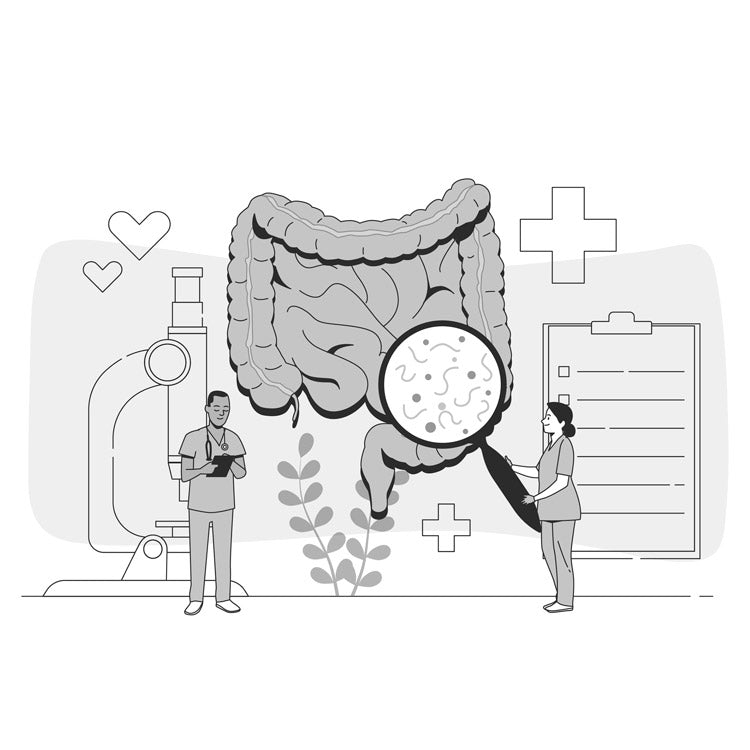
COLON HEALTH
Because the production of mammalian lignans from plant lignans occur in the colon, it has been suspected that lignan supplementation might also help reduce the risk of colon cancer. There’s also research showing that hormones could play a role in this type of disease. (113) (63)
A study looking at 115 colorectal cancer patients showed they had significantly lower levels of serum enterolactone (ENL) levels as compared to a control group (75), while a case cohort study of over 50,000 Danish participants aged 50-64 where higher levels of ENL were associated with lower levels of colon cancer (76), while another case cohort study in the Netherlands found higher levels of enterodiol (ED) and ENL were associated with lower colorectal adenoma risk. (122) In-vitro studies also showed the possible benefit of ENL.(74)
An animal study looking at the impact of Flaxseed and SDG lignans supplementation showed a 41-53% reduction of colonic aberrant crypts and 48-57% reduction of aberrant crypt loci. (44) While in-vitro studies on human cancer colon cells showed that mammalian lignan enterolactone (ENL) significantly reduced the proliferation of such cancer cells (74) (33).
Epidemiological and animal studies point to possible beneficial impacts of lignans on colon health.
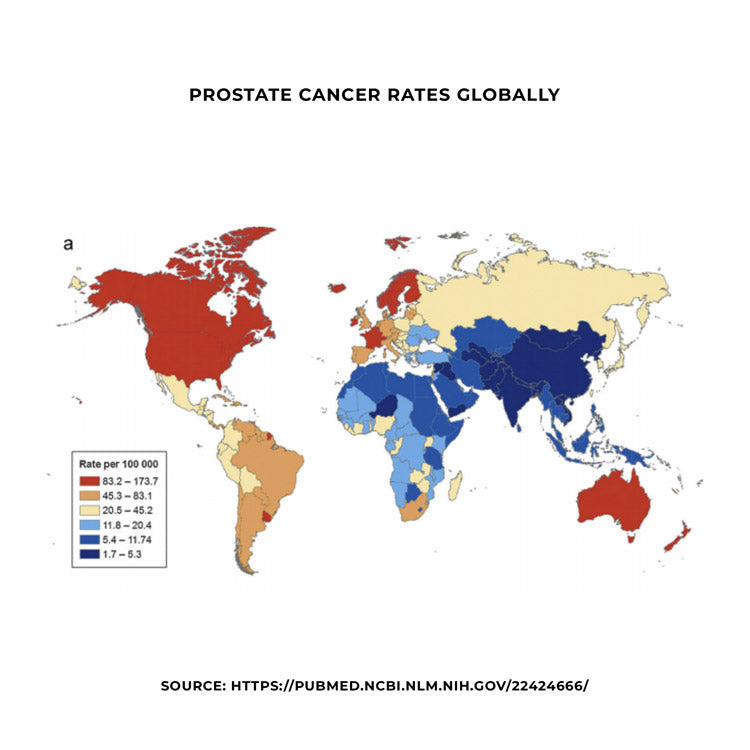
PROSTATE HEALTH
Prostate cancer is the second most common cause of cancer among men worldwide. Similar to what is seen with breast cancer, incidence of prostate cancer is highest in North America and Europe, with Asian populations showing lower incidence of the disease. (63) (79) Incidence rate and mortality rates are 60 and 17 times higher respectively when comparing the United States and China . (25)
According to epidemiological studies, as well as in-vitro and in-vivo studies, there is evidence suggesting that iso-flavanoids and lignans, both phytoestrogens, could be protective against the proliferation of prostate cancer. (63)(70)(116) ENL was also found to have anti-proliferative properties on prostate cancer cells. (25) A case-control study conducted in Scotland found that higher serum ENL concentrations were associated with a lower risk of prostate cancer. (118)(61) In a meta analysis of 11 studies, increased serum concentration of enterolactone was associated with a significant reduced risk of prostate cancer (80)
In a specific in-vivo study seeking to examine the effect of 7-hydroxymatairesinol (HMR) on LNCaP tumours in nude mice, HMR from the Norway Spruce was administered.
Animals in receiving HMR had a reduced tumour take rate, increased percentage of non- growing tumours, and higher tumour cell apoptotic index, compared to a control group (24).
It is also been researched that ENL is a inhibitor of the enzyme 5α-reductase, the same enzyme that is targeted by finasteride a drug used for benign prostatic hyperplasia.(63) The inhibition of 5α-reductase could also play a role in inhibiting the conversion of testosterone to 5a-dihydrotestosterone (DHT). The reduction in DHT concentration has been shown to modify the risk of prostate cancer and benign hyperplasia. (63)(21)
Prostate health is an increasingly important concern for aging men, and lignan supplementation provides some evidence to be supportive for prostate health.

CARDIOVASCULAR HEALTH
Diets rich in foods containing lignans (whole grains, nuts, seeds, legumes, fruits, and vegetables) have been associated with possible reductions in risk of cardiovascular disease.
The anti-oxidant nature of these polyphenols is thought to be the key to their benefits.
Lignans may protect against cardiovascular diseases (CVD) and the metabolic syndrome by reducing lipid and glucose concentrations, lowering blood pressure, and decreasing oxidative stress and inflammation. (61)
Five studies using flaxseed lignan supplements indicated beneficial associations with C-reactive protein, and a meta-analysis that included these studies also suggested lignans have a lowering effect on plasma total and LDL cholesterol. (89) (48)
In a study on 2684 Finnish men between 1984 and 1989, high ENL plasma levels were associated with a reduced coronary heart disease and cardiovascular heart disease (48), while another study of 570 men from the Netherlands, the intake of lignan matairesinol was inversely associated with mortality due to CHD, CVD, cancer, and all causes. (69)
A meta-analysis of 8 different studies looking at ENL plasma levels found that increased ENL levels were associated with a 45% decrease in CVD mortality risk. (65)

OBESITY
In the mouse liver, the fat-rich diet inhibited regulators of lysosomal biogenesis and autophagy pathways such as the master gene TFEB in parallel to an increase in fat accumulation and the induction of severe steatosis, in line with the observations of Settembre et al.( 36 ) who showed that autophagy is required for lipid degradation via the TFEB pathway. 7-HMR and TEP increased TFEB to levels found in the liver of mice on the LFD (10 % fat), suggesting that the TFEB-regulated pathway may be one of the mechanisms through which lignan can prevent liver steatosis. Amelioration of liver steatosis was also investigated in vitro by using the HEPA 1–6 model. (30)

GLYCEMIC SUPPORT
The global prevalence of diabetes among adults over 18 years of age rose from 4.7% in 1980 to 8.5% in 2014 and is becoming an increasing problem in today’s world. WHO estimates that diabetes was the seventh leading cause of death in 2016.(*)
There is growing evidence of beneficial effects of lignans on insulin resistance, glycemic control and obesity. (128)
SDG lignans, for example, have been shown to be effective in preventing/delaying the development of type-1 and type-2 diabetes. The hypoglycemic effect of SDG in type-2 diabetes has been suggested to be due to its antioxidant activity. (61)(121)
In one in-vivo study, flaxseed lignans prevented diabetes in 75% of the cases in rats treated with a diabetes promoting chemical. (105) (117) In a Chinese double-blind randomized control trial with 73 participants, daily lignan supplementation resulted in improvements in glycemic control in type 2 diabetic patients. (66)
In another in-vivo study using specifically HMR lignans and norwegian spruce extract, mice being fed a high-fat diet showed improved glycemic control. Compared to a control, the subjects fed the extract had significantly lower weight, lower insulin resistance, and lower fasting glucose levels. (30)
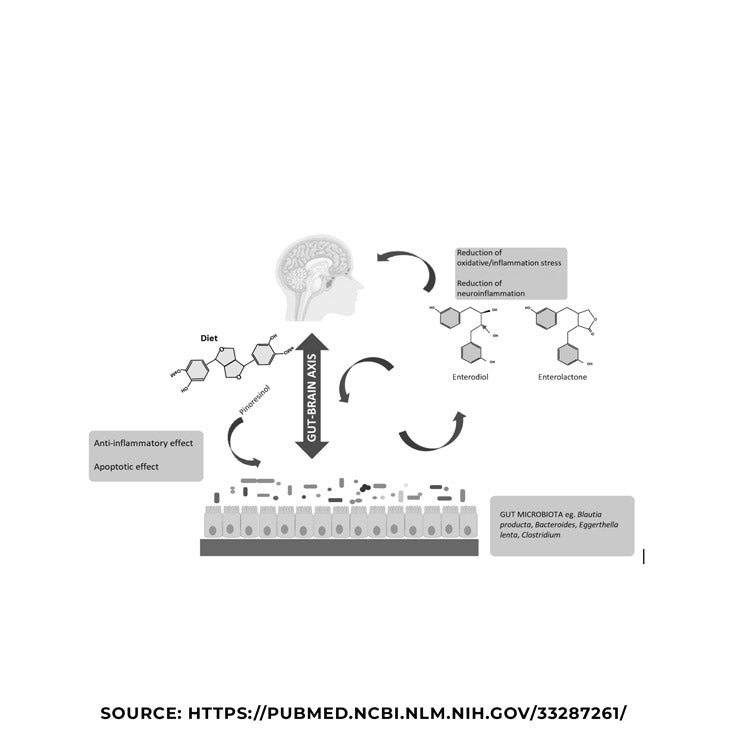
BRAIN HEALTH
A growing amount of research is linking diet, inflammation and cognition. Similar to other diseases covered, the Western Diet has been associated with higher incidences of neurodegenerative diseases.(124)
In the past several years, several research works demonstrated that dietary polyphenols could have beneficial effects in cognitive functions, by acting against oxidative stress and inflammation. Alteration in the homeostasis of the gut–brain axis has been associated also to neurological disorders and neurodegenerative diseases. (86) This has lead to research on diet, the microbiota-gut-brain axis and its implications in neurological disorders (110)
In terms of general diet, the Mediterranean Diet and Asian Diet have been shown to prevent a variety of pathologies associated with aging. In fact, it is suggested the polyphenols in these diets that are associated with the greatest reduction in neurodegeneration (110)
Polyphenols, as antioxidants, act as free radical scavengers, and thereby afford protection from chronic diseases, such as Alzheimer’s disease and diabetes, in which free radicals play a major role in the pathogenesis.
There is some evidence that lignans could play a role as an acetylcholinesterase inhibitor, which is shown to have a neuroprotective effect, as acetylcholinesterase breaks down acetylcholine, a neurotransmitter. (81) (86) Alzheimer’s patients, for example, have been found to have low levels of acetylcholine in their brain.
As a further example, ENL was found to attenuate the degeneration of the striatal dopaminergic terminals in Parkinson’s disease (PD), in the PD rat models (43), while Polyphenols appear to have a positive effect on the gut microbiome, which may decrease inflammation that contributes to the disease. Therefore, a diet rich in polyphenols may decrease the symptoms and increase quality of life in PD patients. (110)
dietary polyphenolic compounds are potentially able to affect the gut–brain axis
via modulation of the gut microbiota, (86)


